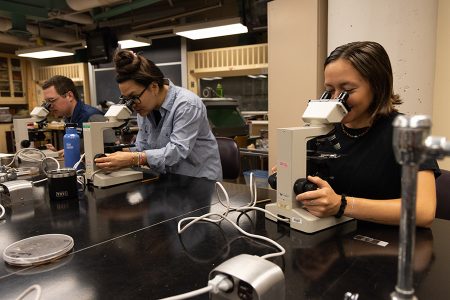The COVID-19 pandemic may be receding, but the questions it raised about our ability to respond to public health crises remain — namely, are we ready for another pandemic?

The short answer to that question seems to be “no.” We sorely need many more public health workers and, at a national level, we haven’t yet healed the deep ideological divisions that emerged during the COVID-19 pandemic.
And, yet, in perhaps one of the few silver linings of the pandemic, awareness of our public health workforce and the critical role it plays in the overall health of the country has spiked dramatically. For example, when SPH Associate Professor JP Leider started working in public health more than 15 years ago, his friends and family were mystified by his job. “Now I’ll never have to wonder if my family understands what I do,” quips Leider, who also serves as director of the SPH Center for Public Health Systems (CPHS).
Neglect, Panic, Repeat
That bright spot aside, the pandemic inflicted a heavy toll on our nation’s public health workforce, which was already reeling from years of uneven government investment. The U.S. has long taken a “neglect, panic, repeat” approach to public health funding: ignore the problem, respond to crises with one-time funding, then ignore it again until another emergency arises.
As a result, the current state of the public health workforce is dire. The demands of the pandemic — long hours, intense stress, politicization of public health efforts — combined with chronically low wages led thousands of public health workers to leave their jobs over the past three years. And, in a recent survey, nearly one-third of state and local public health employees said they are considering quitting in the next year.
To meet the nation’s basic public health needs, state and local health departments across the country needed to hire a minimum of 80,000 additional full-time governmental public health workers before COVID-19 even hit — an increase of nearly 80% over current staffing levels — according to recent CPHS research. If left unresolved, the workforce challenges will undermine our nation’s ability to protect the public’s health.
Rebuild, Regrow, Reinvest
The good news? Policymakers are investing in public health systems at historic levels, and billions of dollars are flowing into state and local health departments aimed specifically at rebuilding the public health workforce. The CDC recently awarded $3.8 billion for governmental public health efforts.
With leading-edge research and programs, and nationally recognized leaders among its faculty and staff, SPH is on the front lines of harnessing this new funding to address the nation’s public health workforce challenges. In a recent visit to the school, U.S. Senator Tina Smith hailed SPH as a “national leader in addressing the public health workforce shortage.” During Smith’s visit to the school, SPH faculty emphasized the need for stable funding, but the focus of the visit was SPH’s innovative training, research centers, and collaborations.
Here’s a look at just some of the ways SPH is helping to modernize, strengthen, and expand the public health workforce:
Train the Next Generation of Leaders in the Public Health Workforce — and Diversify it
For nearly 80 years, SPH has been at the forefront of public health education in Minnesota and almost 70% of the state’s public health professionals received their training at the University of Minnesota. Through a rigorous, academic experience combined with hands-on learning, SPH’s graduate programs have served as a hub for preparing generations of students to enter the public health workforce.
This year, SPH expanded its commitment to meeting Minnesota’s critical need for a skilled, diverse public health workforce by launching a new bachelor of arts degree in public health — the first-ever undergraduate degree SPH has offered. UMN Executive Vice President and Provost Rachel Croson cites the pressing need for strengthening and diversifying the public health workforce as driving the University’s decision to add the new degree program. “The world needs leaders in public health now more than ever,” she says.
The urgent need to address those challenges inspired the “Public Health Traineeship” scholarship program, a partnership between SPH and the Minnesota Department of Health (MDH) focused on reducing public health inequities, improving emergency preparedness throughout the public health system, and increasing the size of the public health workforce. With funding from the Health Resources & Services Administration (HRSA), the program provides students with hands-on experience working in public health through an internship at MDH.
“The world needs leaders in public health now more than ever.”
Rachel Croson
Increasing and diversifying the public health workforce motivates another unique SPH partnership. Training in Informatics for Underrepresented Minorities in Public Health (TRIUMPH) is a first-of-its-kind consortium led by SPH and the UMN School of Nursing to train students in informatics at five schools that have historically served Black, Latine, and Native American people.
“Informatics is a critical skill set for the public health workforce, yet we saw during the pandemic that we don’t have accessible, real-time health data — especially for underrepresented communities that were hit hardest by the pandemic,” says SPH Professor and TRIUMPH co-leader Dr. Rebecca Wurtz. Just two years into the four-year project, about 350 students across the five schools have received training in informatics, helping to diversify the workforce and ensure that the data collection challenges of the pandemic are avoided in the future.
Research of Public Health, by Public Health, and for Public Health
Surprisingly, we don’t know the exact size of the public health workforce. The U.S. Bureau of Labor Statistics — which meticulously documents everything from national unemployment data to the current rate of inflation — doesn’t count “public health worker” as an individual occupation, meaning that the government doesn’t know for sure how many people are employed in state and local public health agencies across the country.
Enter the Consortium for Workforce Research in Public Health (CWORPH), an SPH-led collaboration among six universities dedicated to analyzing the nation’s public health workforce. Supported with a first-of-its-kind joint $4.7 million cooperative agreement from the CDC and HRSA, the consortium has already emerged as the national home of public health workforce research in the country. CWORPH’s current areas of focus include identifying key gaps in the diversity and equity of the workforce, estimating workforce supply versus demand, and measuring the use of community health workers in health departments across the U.S.
SPH’s Center for Public Health Systems (CPHS), which is the administrative home of CWORPH and TRIUMPH, conducts research that is directly supporting the public health workforce. CPHS was founded in 2021 to support governmental public health and advance public health systems research. In the years that followed, billions in federal dollars have flowed into state and local public health departments, some of it earmarked specifically for workforce development. “The workforce itself is the biggest component of what makes public health possible, and for the first time, the workforce as its own thing is being funded,” Leider says. CPHS supports public health agencies across the country with technical assistance and conducts a broad range of innovative research on public health workforce, finance, infrastructure, and policy — both in Minnesota and on the national level. “I see our role at CPHS as supporting public health agencies,” Leider says. “There is a sea of need out there, and we’re trying to help agencies figure out how to meet it.”
CWORPH and CPHS are already making an impact. Earlier this year, the Public Health Accreditation Board awarded CWORPH and CPHS $4.2 million to conduct a comprehensive analysis of the nation’s public health workforce. The analysis, which will determine the current size, distribution, and characteristics of the workforce, is the first analysis of its kind since 2014.
A multidisciplinary, health policy research center with a focus on state policy, the State Health Access Data Assistance Center (SHADAC) also supports existing state health officials across the country by serving as an “extra set of hands.” SHADAC Deputy Director Elizabeth Lukanen says that researchers at SHADAC often see themselves as extended co-workers, offering technical support to the public health agency staff who call them for help. “Many of us worked in state government with limited budgets and limited bandwidth, so we really get it,” she says. “So what we try to do for them is say, ‘What can we take off your plate? How can we package the research to support your decision-making?’ ” That attitude is a key reason SHADAC has developed a national reputation for helping state and local public health agencies translate complex research findings into accessible, actionable information.
Where Do We Go From Here?
We might not be ready for another pandemic just yet, but there is evidence that we are moving in the right direction. After decades of uneven investments in the public health workforce, the federal government is finally focused on rebuilding our public health infrastructure. And more young people are seeking careers in public health; over the past decade, there has been a dramatic increase — over 1,100% — in the number of students seeking degrees in public health.
Perhaps most importantly, many Americans now recognize the essential role the public health workforce plays in keeping all of us safe. Fewer people wonder what public health workers do, or question their importance. We may not be able to prevent the next pandemic, but with a strong public health workforce trained and supported by places such as SPH, we can be fully prepared for it.
Lessons Learned from the Pandemic: MNPrepared
SPH’s MNPrepared is a federally funded program with two goals: strengthen the public
health workforce by broadening the pathway to public health careers, and revitalize the training of public health professionals by improving emergency preparedness training materials. SPH Professor and MNPrepared principal investigator Craig Hedberg describes the program as a direct response to lessons learned from the COVID-19 pandemic.
“There was an acknowledgment that we needed to reinvest in the public health workforce, both in terms of bringing in younger people and providing training for people who are already in the system,” says Hedberg. Just a few months into the grant, MNPrepared is already having a statewide impact — more than 20% of participants have been placed in local public health agencies throughout Greater Minnesota, while many others are working on key public health priorities at MDH.
Public Health Institute
For public health practitioners and students in health-allied professional programs looking to expand their skills, stay current on best practices, network with other professionals, or just explore an area of interest, there is SPH’s Public Health Institute (PHI), an innovative menu of short-format courses geared towards trending topics in public health, many offered virtually.
“PHI is a real mix of people from various backgrounds,” says program director Meghan Taylor, adding that participants at last year’s institute came from 17 different states. “PHI is open to anyone who wants to learn more about public health, so in addition to traditional students, we also attract a lot of people who have been working in public health for a number of years and maybe want to brush up on a topic or learn about the latest research in a particular field.”
PHI courses typically include an experiential component such as a case study, lab work, or a field trip. Many classes are also taught in partnership with government agencies, non-profit organizations, and industry groups to ensure that participants are receiving the latest public health training.


